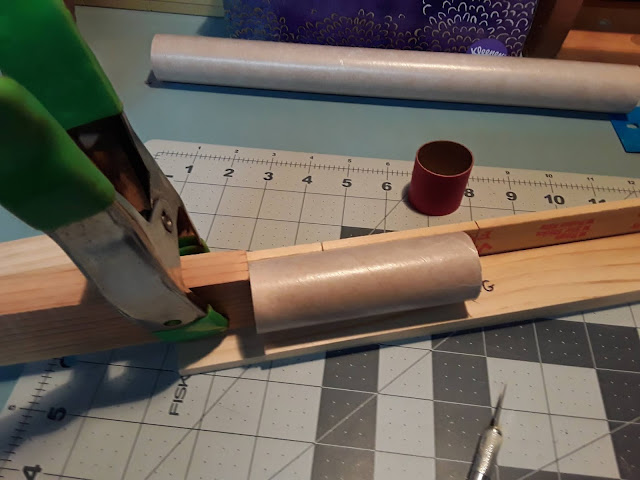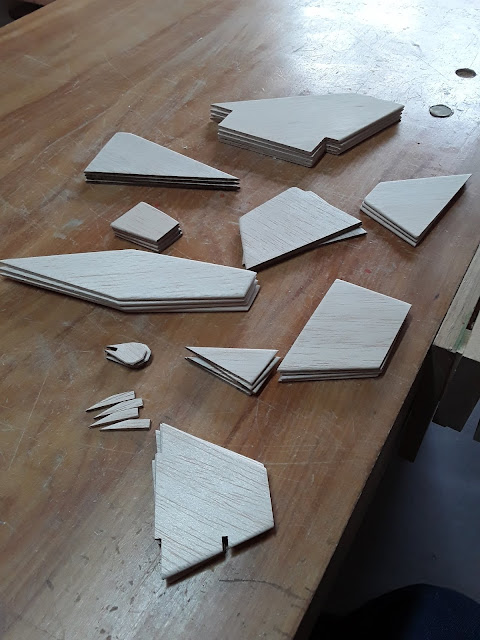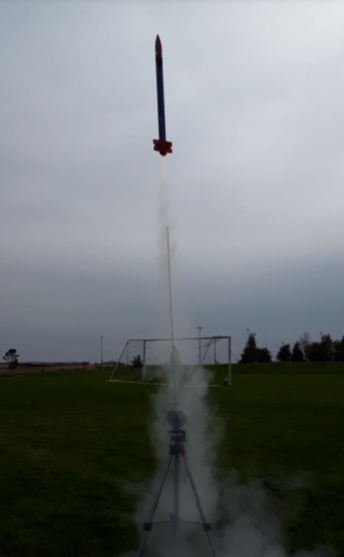After several weeks of launching inactivity here in the central Colorado Front Range area, we finally were blessed with an ideal day. This was after an extended period of unhealthy air quality due to all of the western wildfire smoke coupled with incessant wind conditions.
Lee Reep, Mike Goss, Jim Gazur, and Yours Truly converged on Dove Valley Regional Park for a morning launch session in near-perfect windless conditions. Great time to break out the gliders and higher-powered flights.
Lee Reep started things off with a great flight of his Estes Recruiter. The model logged two excellent flights - one on a C11-3, and later, powered by a D12-3.
My first flight of the day was made with the old Mini-Brute Hornet.
This was the 50th and final flight for my first model rocket. It carried a payload of two U.S. dimes - dated 1973 and 2021, representing the years of its first and last launches.
Today, old #13 turned in a perfect flight on A3-4T power, drifting in under parachute close to the launch area. I was even able to run and catch it in mid-air! The Hornet is now officially retired.
By this time, Jim Gazur and Mike Goss had arrived.
Mike quickly prepped his firs bird of the day, an Art Applewhite Paper Copter. Flying on an A10-PT motor, the model turned in a low and very amusing performance.
Since wind conditions were so perfect, I decided it was time to fly a boost/glider. Honors went to a 1/2A6-2 powered Wasp.
Boost was perfect, but at ejection, the shock line broke, and the glider with pod still attached plummeted to the turf. Surprisingly, the model sustained no damage.
Mike soon had his next bird on the pad, a Mini Mars Lander.
The model flew nicely on an A10 motor, but the parachute failed to eject. Despite a rather hard landing, the model survived with no damage. He later sent the model aloft for a second flight, this time enjoying a successful parachute deployment.
My next flight again featured glider action. This time it was an MPC Lunar Patrol clone.
The model turned in a picture perfect flight on a B4-2 motor. Both gliders detached and settled into well trimmed glides. All three components were safely recovered within close proximity to the launch area.
Lee Reep launched a beautifully finished Semroc Squire on an A8-3 motor. Flying low on the given impulse, the model turned in a great flight, landing close to the launch pad.
Mike was soon back at it with an interesting model - a scratch-built Cyclone employing 'maple-seed recovery. Flying on 1/2A-3T power, the model flew very well. Both sections spun rapidly on descent, making for a very outstanding sight!
My model box contained one more glider model: a scratch-built Orbital Transport. On ignition, the bird boosted nicely, but then arced over and started heading downward. The B6-4 motor's ejection charge went off after the model had descended by about half of its achieved altitude. In addition, there was no parachute deployment. The orbiter did separate and glide very well. Upon recovery of the model, I found the parachute stuck in the body tube. The two lower wing rudders had been knocked off on the landing. Easy repair. I'm not sure why the model's flight path behaved in this manner. It had been flown previously on a B6-4 with no problems.
Now that I was done flying gliders, it was time to break out the Quest Big Rage for a video cam flight.
The model turned in a perfect flight on a C6-5, and returned close to the launch area.
Again, I ran to catch it, just barely brushing the shock cord with my fingertips.
Anyway, here's a still from the flight video showing my rocket-borne selfie:
An Estes Mini Honest John was the next model sent skyward by Mike Goss. The little bird turned in a perfect flight on an A10-3T motor.
Lee Reep got back into the action again, with a very nice B4 powered flight on a kitbash of an Estes RTF model, which he hasn't given a name.
So far wind conditions were perfect, and none of the models flown strayed very far from the launch area.
Where was Jim Gazur during all this? Prepping an interesting model, of course. Jim never disappoints when it comes to flying unusual, and spectacular, models.
This time it was a Soviet N1 Moon Rocket featuring 3D-printed parts from David Koo. Jim flew the highly impressive-looking bird on an Aerotech F67-4W motor for a spectacular liftoff. The model carried a Perfectflite altimeter which gave an altitude reading of 220 feet.
Surprisingly, the thrust of the F67 was enough to completely shatter a ceramic tile blast deflector!
Kudos to Jim for being probably the first rocketeer to fly an F motor successfully at Dove Valley Park!My next launch went to a Cherokee-E on a D12-5.
Textbook flight with a straight up boost, perfect parachute deployment, and recovery close to the launch area. Again, I just barely missed catching the model as it descended. One for three...
Mike put up a very nicely built and finished Estes Puma.
The model boosted nicely but experienced a para-wad recovery. No damage, however.
Next out of my model box was a Quest Nike-K on a C6-5 motor.
For some unexplained reason the model tipped off during boost and described a severe arc toward the north. Everyone lost sight of the model. Surprisingly, I just happened to catch a brief glimpse of it hanging under parachute just seconds before it drifted below the grass berm at the park perimeter!
The model was found about 50 feet within a weed field across the street.
In the meantime Jim Gazur had his next bird prepped and ready to go. This time it was a 1:24 scale V2 from Spacemonkey Models.
The impressive model flew on a Quest D20-4W motor, and carried an Eggtimer Apogee flight computer to handle parachute ejection.
Unfortunately, there was no recovery system deployment, so the flight ended in the day's one and only 'lawn-dart.
Surprisingly, damage to the model was only in the form of a split internal stuffer tube. The V2 will live to fly another day! Jim later discovered that the cause of the failure was the result of the Apogee electrical connector separating during boost.
Mike Goss put up an amusing flight with a LOC IV model. Flying on a 1/2A6-2 motor, the model reached a peak altitude of perhaps 15 feet, popped its 'chute and floated down next to the launcher!
My final flight of the day was made with a scratch-built Satellite Interceptor. Flying on a B6-4, the model boosted nicely, but the parachute separated at ejection. The model free-fell in a horizontal position, thus landing moderately softly on the turf. Not a scratch!
Lee Reep finished things off for the day with a very nice launch of his 40-year-old original Estes Trident (!) This flight marked Lee's first use of one of the new C5-3 motors. It fit the bill nicely.
With that done, the intrepid group of BARs packed up and vacated the field after a perfect day of model rocket flying.Here's a parting shot of Lee and Jim engaged in deep on-field conversation - talking rockets, no doubt!































































